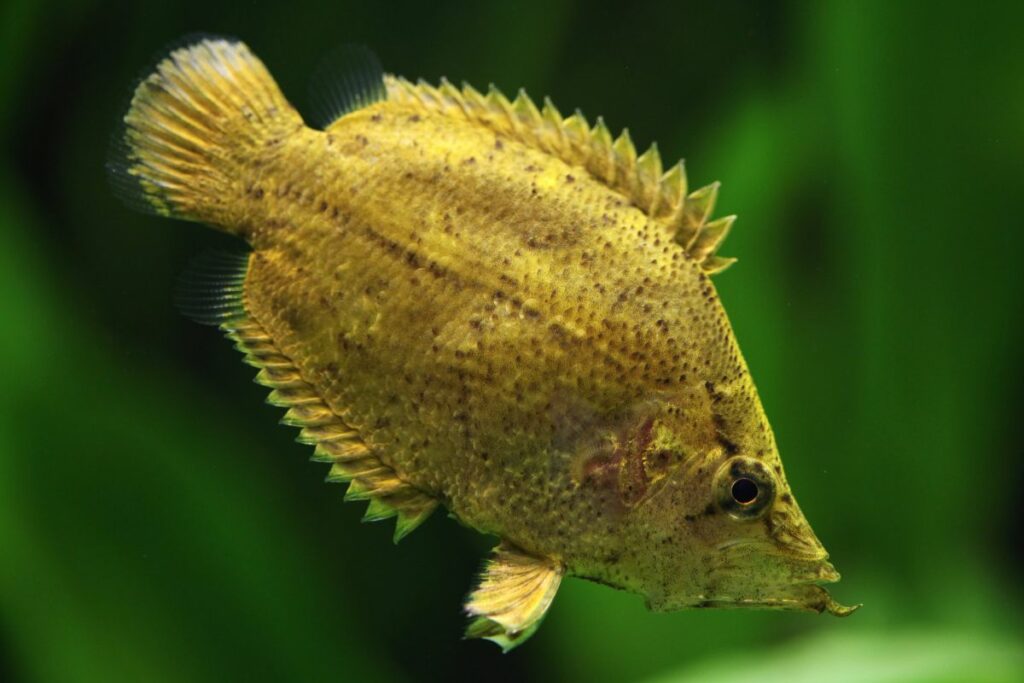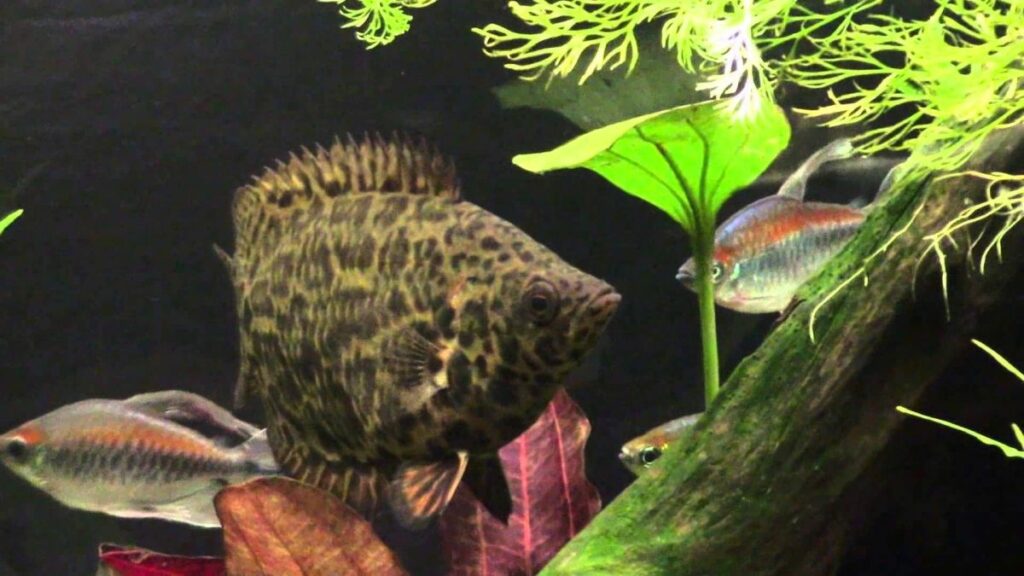Leaf fish are camouflaged predatory fish that are suitable for well informed beginners to advanced level aquarists. Unlike other carnivores in the aquarium hobby, leaffish won’t outgrow most tanks.

Leaffish are capable of changing their color and patterning to match the background. They will turn a dark chocolate brown when lurking among a tangle of driftwood. And when they float among plants they turn a cryptic light brown with dark blotches and stripes.
There are two species in the trade: the Amazon leaf fish (Monocirrhus polyacanthus) and the African leaf fish (Polycentropsis abbreviata). The African species grows no larger than 3 inches but is a chunkier fish. Both species have identical care requirements, however.
- Common Names: Amazon Leaf Fish, South American Leaf Fish, Spotted African Leaf Fish
- Scientific Name: Monocirrhus polyacanthus (Amazon), Polycentropsis abbreviata (African)
- Origin: Amazon & Congo River basins
- Length: 3 to 4 inches
- Leaffish Lifespan: 5 to 8 years
- Aquarium Size: 30+ gallons
- Temperament: Peaceful; Predatory
- Ease of Care: Moderate
Setting Up a Leaf Fish Tank
A leaf fish aquarium should cater to their desire to hide. They do best in tanks with abundant live plant growth, driftwood knots, and dim lighting. If your light is on the brighter side, leaf fish will bleach in color, stress, and spend even more time hiding. Use floating plants to help reduce illumination into the tank if your lights don’t have a dimmer.
Choose live plants that would also do well in a discus tank since leaf fish prefer higher water temperatures. Amazon sword plants and other South American aquarium plants are great species to aquascape with. As are Asian aquarium plants like hygrophila sp., Java ferns and Java moss.
Leaf Fish Water Conditions
The main difficulty in caring for a leaf fish is providing the right water conditions. These fish come from tropical equatorial regions deep in the rainforests of Africa and South America. The hard, alkaline tap water found in most places won’t suit them.
You need to adjust your water chemistry by lowering the pH to a range of 4.0-7.0. Softening the water by using mineral absorbers or reverse osmosis sources also helps.
If you use plant tannins to create acidic conditions the chemicals will stain the water tea colored. Blackwater tanks are beautiful natural biotopes. The dark water also reduces light even more, helping your leaf fish feel more comfortable.
I also recommend adding Indian almond leaves. These leaves will adjust the water parameters towards acidity and draw attention to the camouflage of your leaf fish.
The aquarium’s water temperature should be 77-82℉. Colder conditions will cause them to catch ich, fin rot, and other infections. Their appetite will also be reduced and breeding won’t happen.
What Do Leaf Fish Eat?
Amazon leaffish are ambush predators that feed on smaller fish and invertebrates. Young leaf fish feed more on worms, small shrimp, and aquatic insects. Adults switch to eating other fish but will consume an occasional insect.
The mouth of a leaf fish is a remarkable testament to the power of evolution. They are suction feeders, similar to anglerfish and other marine ambush hunters. Instead of grabbing their prey a South American leaf fish tries to drift as close as possible.
Prey mistake them for leaves and ignore the leaffish until it’s too late. Even if it’s an inch or two away, it will snap open its mouth to suck in a nearby animal.
Adult leaf fish have a mouth that is 60% as long as its entire head. They are capable of swallowing prey between ⅓rd and ⅔rds their own body length.
Since the majority of African leaf fish are wild caught, you should start feeding them live food. Feeder guppies, rosy reds, and goldfish of the right size are ideal. Try to screen any feeders for diseases like aquarium fish ich before offering them to your leaf fish.
Feeder fish are kept in terrible conditions and will pass on parasites to your South American predatory fish. Mix in live invertebrates every so often like ghost shrimp and tubifex worms. If you breed your own ghost shrimp or feeder guppies you will ensure you have a parasite-free source of food for your leaffish.
Weaning leaffish onto prepared food is difficult because they are cued to sense motion. It is possible, however. One way is to offer dead and live feeder fish at the same time. Once they’re accustomed to eating dead food, you should mix pellets or frozen food with their dead feeders. It’s not a sure strategy, though. You may have to offer live food at all times.
African Leaf Fish Tank Mates

Leaffish are often described as “aggressive,” but that’s not true. They are predatory so they see smaller tank mates as prey. Any fish too big to be eaten will be ignored by a leaf fish.
You should choose fish that are similar in size or larger. Leaf fish tank mates should be peaceful to semi-aggressive. But not too aggressive since leaf fish aren’t territorial nor do they have large teeth to fight back if attacked.
Medium sized South American cichlids like discus, angelfish, severums, and electric blue acaras will coexist with a leaffish. Armored catfish like plecostomus, bristlenose plecos, and twig catfish are too big and spiny to make good meals. The same is true for larger species of corydoras.
Deep bodied community fish like tiger barbs, gouramis, clown loaches, and silver dollars are excellent dither fish. They will encourage the shy leaffish to swim out in the open more.
Stay away from smaller species like tetras, rasboras, and danios. Livebearing fish, even larger ones like mollies, are slim enough to be leaffish food even when full grown. Shrimp are on the menu for a leaffish but snails are a safe invertebrate option.
How to Breed Leaf Fish
Leaf fish are moderate in breeding difficulty. Once you have the water conditions right, they may spawn. But telling males from females is impossible by sight. A pregnant female will be more swollen than a male but that’s all you have to go by. It’s possible that leaf fish use behavioral or chemical cues to signal to each other.
Amazon leaf fish are similar to cichlids when it comes to breeding them. The pair will clean a flat surface for spawning, such as a piece of slate or the surface of a sword plant leaf. They will deposit their eggs there. The male then guards them until they hatch in 3 to 5 days.
During their first few days of life the baby leaf fish feed on their yolk sack and microorganisms. A mature planted tank will grow infusoria on its own. But if your tank does not have much infusoria or biofilm you should culture some beforehand.
Leaf fish fry don’t become free-swimming until 5-7 days after hatching. When they are no longer attached to the spawning site they are large enough to eat live daphnia and baby brine shrimp. You have to offer live food at first or the fry will starve. Once the fry are about an inch long you should switch to feeder guppies and live adult brine shrimp.
Conclusion
Leaf fish are modest sized carnivores that don’t require as much space as an arowana or other big predators. Providing the right water conditions and lush plant growth are the most difficult parts of caring for a leaffish. Also be sure to choose tank mates with care and provide plenty of live food.
FAQs
Leaffish are not easy to find in chain retail pet stores like Petsmart since they will eat most of the other fish they sell. But most aquarium specialty stores will either have them or be able to order one for you. South American leaf fish are the more common of the two species. Neither species is too expensive; expect to pay $10-20 for a single leaf fish.
Leaf fish are predatory but they aren’t aggressive towards fish too big to be eaten. Choose deep bodied or armored tank mates like tiger barbs, angelfish, plecostomus, and cichlids. Any cichlid species you choose should not be too aggressive as leaf fish are slow swimmers and won’t be able to defend themselves.

